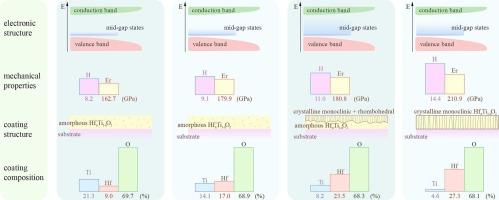The growth of oxygen vacancy controlled HfxTi1-xO2 layers deposited by gas injection magnetron sputtering technique
IF 6.9
2区 材料科学
Q2 CHEMISTRY, PHYSICAL
引用次数: 0
Abstract
HfxTi1-xO2 layers (0.3 ≤ x ≤ 0.86) were grown by the Gas Injection Magnetron Sputtering (GIMS) technique. Binary Hf-Ti targets with the Hf/Ti atomic ratios of 1/4, 2/3, 3/2, and 4/1, fabricated using plasma surface sintering, were used for reactive sputtering in the fixed Ar/O2 gas mixture. The initial growth of the GIMS-deposited HfxTi1-xO2 layers was characterized by an amorphous structure, which crystallized along the oxide layer growth direction when the Hf content was sufficient (x > 0.74). The lattice structure of oxide layers with x ≤ 0.86 exhibited monoclinic crystallization, which is characteristic of HfO2. However, when x = 0.74, a highly non-equilibrium mixture of monoclinic and rhombohedral HfO2 phases was formed. The XPS study showed that these layers’ Hf-Ox and Ti-Ox bonds were locally O-deficient, indicating that oxygen vacancies control the formation of HfxTi1-xO2. The optical properties of the fabricated layers also changed markedly when the chemical composition was modified. For example, an increase in the Hf fraction reduced the extinction coefficient from 1 to 0.2 at 250 nm and the refractive index from 2.45 to 2.3 in the visible range. We indicated that oxygen vacancies create the mid-band states, shifting the absorption towards lower energies. As the x value was increased from 0.30 to 0.86, the corresponding absorption shifted from 3.20 to 2.55 eV. In addition, Hf-rich layers revealed a significant increase in hardness and reduced Young’s modulus by 73 % and 30 %, respectively. All layers were also hydrophobic.

利用气体注入磁控溅射技术沉积的氧空位控制 HfxTi1-xO2 层的生长
采用气注磁控溅射(GIMS)技术生长出0.3≤x≤0.86的HfxTi1-xO2层。采用等离子体表面烧结法制备Hf/Ti原子比分别为1/4、2/3、3/2和4/1的二元Hf-Ti靶材,在固定Ar/O2混合气体中进行反应溅射。gims沉积的HfxTi1-xO2层的初始生长表现为非晶结构,当Hf含量足够时,沿氧化层生长方向结晶(x >;0.74)。x≤0.86的氧化层晶格结构表现为单斜晶化,这是HfO2的特征。然而,当x = 0.74时,形成单斜相和菱形相的高度非平衡混合物。XPS研究表明,这些层的Hf-Ox和Ti-Ox键局部缺氧,表明氧空位控制了HfxTi1-xO2的形成。当化学成分发生改变时,制备层的光学性质也发生了明显的变化。例如,Hf分数的增加使250 nm处的消光系数从1降低到0.2,可见光范围内的折射率从2.45降低到2.3。我们指出,氧空位产生了中带态,将吸收转移到较低的能量。当x值从0.30增加到0.86时,相应的吸收从3.20 eV移动到2.55 eV。此外,富hf层的硬度和杨氏模量分别显著提高了73%和30%。所有的层都是疏水的。
本文章由计算机程序翻译,如有差异,请以英文原文为准。
求助全文
约1分钟内获得全文
求助全文
来源期刊

Applied Surface Science
工程技术-材料科学:膜
CiteScore
12.50
自引率
7.50%
发文量
3393
审稿时长
67 days
期刊介绍:
Applied Surface Science covers topics contributing to a better understanding of surfaces, interfaces, nanostructures and their applications. The journal is concerned with scientific research on the atomic and molecular level of material properties determined with specific surface analytical techniques and/or computational methods, as well as the processing of such structures.
 求助内容:
求助内容: 应助结果提醒方式:
应助结果提醒方式:


